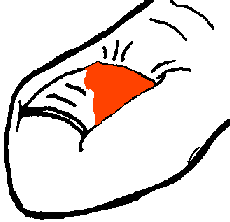Sports injuries
Sports injuries
The field of sports injuries is a vast one in itself and this page can only give a brief overview of some of the more common problems. However, the basic treatment for all sports injuries is the same and easily memorised using the mneumonic PRICE:
Prevention (of future injury). This is really common sense. For instance, if a particular pair of training shoes have caused a blister, or if an inadequate warm up has resulted in a muscle strain, make sure that you address the cause of the injury! If abnormal biomechanics are involved, get checked out by your Podiatrist in case a pair of orthotics would be advisable (see the Biomechanics & Orthotics page!).
Rest – most important and often neglected. If you exercise on an injury which has not healed up properly, it will simply make it worse and probably mean that you are out of action for longer. If you feel the urge to exercise, try and pick an alternative sport which rests the affected area – for instance, if you have a painful knee, a sport such as swimming where stresses on the knee are reduced would be much better than running or playing tennis. When you do start exercising the affected area again, take it very gently at first so that if there are still any problems, you become aware of them and can stop before they become severe again.
Ice (or cold therapy) is excellent for reducing inflammation and swelling. The sooner after an injury is sustained and the more frequently it is used, the better the results will be. Early effective treatment with ice packs (e.g. 15 minute applications every hour) will literally take weeks off the healing time for an ankle sprain.
* IMPORTANT * Do not use ice on any areas where your circulation is impaired or where there is infection.
Compression – use of compression bandages to reduce swelling is recommended in any swollen areas. However, do not put it on so tight that it cuts off the circulation, and if in doubt, check with a podiatrist or physiotherapist.
Elevation – also helpful to reduce any swelling in the early stages after an injury. Affected body parts should be raised above chest level for as long as practically possible.
Ankle sprains are very common sports injuries. The picture opposite shows the arrangement of the three main ankle ligaments on the outer side of the joint. These ligaments limit the amount of movement about the ankle joint. If they are overstressed, either due to overtraining, or trauma such as landing in a pothole or tripping, they can be torn. The foot swells up quickly and becomes very painful. Treatment consists of ice, elevation, and compression, and you must expect to wait approximately six weeks (minimum) until the ankle can be exercised again. If the ligaments are sprained regularly, they may become weak and predispose you to this type of injury, in which case an orthotic may be advisable to support the rearfoot and prevent a recurrence (see the Biomechanics & Orthotics page).
 Another common injury is a subungal haematoma, or bleeding beneath the nail plate. This occurs if shoes are too tight or if there is excessive trauma to the nail, such as repetitive kicking in football. The blood clot becomes painful because of the pressure it exerts on the flesh underneath the nail. In the early stages, before the blood clot solidifies, a small hole should be created in the nail to release the blood – an easy way of doing this is to heat a paperclip in a cigarette lighter and then push it through the nail plate, which will melt, creating an aperture.
Another common injury is a subungal haematoma, or bleeding beneath the nail plate. This occurs if shoes are too tight or if there is excessive trauma to the nail, such as repetitive kicking in football. The blood clot becomes painful because of the pressure it exerts on the flesh underneath the nail. In the early stages, before the blood clot solidifies, a small hole should be created in the nail to release the blood – an easy way of doing this is to heat a paperclip in a cigarette lighter and then push it through the nail plate, which will melt, creating an aperture.
Once the blood has been cleared, an antiseptic gauze dressing should be applied to the nail. If the blood has solidified by the time you come to treat it, the nail should be simply left alone as it will not be painful by this point and eventually the blood clot will grow out with the nail, although this will take several months.
